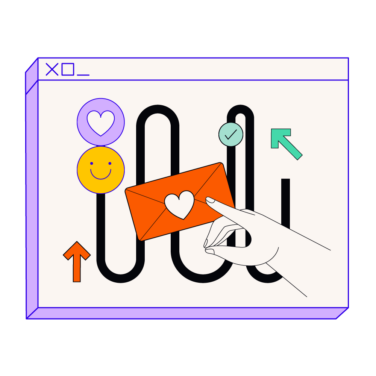Despite the rise customer self-service, the humble phone call continues to be a key communication link between brands and customers. Most consumers would rather have a real human help them through customer service issues.
Even B2B SaaS brands, with their relatively tech-savvy and self-service-inclined audiences, are not immune from the need for call-enabled contact centers. The question, then, is where to focus: inbound call centers, outbound call centers, or a hybrid approach.
In this guide, we’ll explore the key differences between these call center models, look at the specific activities and technologies that define each one, and lay out principles to help you identify which type of call center works best for your business.
Key Differences: Inbound Vs Outbound Call Centers
Inbound call centers handle incoming calls, while outbound call centers focus on proactive outreach. Simple enough, right?
But why bother with the distinction, since agents are—no surprise—making phone calls in both cases? This is a good question, and it leads some businesses to establish hybrid call centers.
Differences in recruitment, training, and systems are the primary reasons for the inbound versus outbound distinction. Inbound call centers are primarily focused on customer service, although they also handle inbound leads. Outbound call centers tend to be more focused on sales. Focusing your call center primarily on one or the other can help streamline your staffing, management, processes, and technology.
Understanding Inbound Call Centers
When it comes to getting answers, customers want speed. 90% of customers consider an immediate response “important” or “very important.” It’s up to brands to meet these high standards, and many of them do not. In 2022, nearly half of consumers reported switching brands for better customer service.
Fortunately, inbound call centers are a key part of the solution: well-trained agents can increase retention, improve loyalty, and boost customer satisfaction.
Inbound Call Center Types
Inbound call centers play a crucial role in providing support and service to customers. Activities of inbound call centers can be grouped into three areas:
- Product and Tech Support: Inbound call center agents help troubleshoot customer concerns, walk through configurations, and effectively utilize your company’s products.
- Administrative Support: Many customers have billing questions, order status inquiries, refunds, account changes and other everyday requests.
- Inbound Sales: When interested prospects call your inbound lines, agents have a prime opportunity to convert them into paying customers. They can also upsell existing customers.
Inbound Call Center Technologies
A 2023 study by Stanford and MIT researchers found that when generative AI technology was deployed to call centers, it increased the productivity of agents by 14%. Compellingly, AI tools had the biggest impact on workers with less experience.
One example of cutting-edge call center tech: Aircall’s Smartflow feature allows customer service leaders to create elegant Interactive Voice Response (IVR) workflows that efficiently route customers to the right agent and integrate with CRM software like Salesforce and HubSpot.

The best inbound call center software includes features like:
- IVR Systems: Interactive voice response systems screen calls, route them to the appropriate agents, and allow easy self-service for common questions.
- Intelligent Call Routing: Using caller ID, number dialed and IVR inputs, calls are automatically queued and connected with available agents with relevant skill sets.
- Call Recording: Recording interactions helps monitor quality, provide opportunities for real-time coaching, and facilitate future training.
- Sentiment Analysis: AI can detect caller emotions based on verbal cues and language, helping agents adjust their approach accordingly.
- AI Notetaking and Agent Assistants: Automated transcription software listens in on calls and updates CRM notes, suggests knowledge base articles, and provides real-time guidance.
Understanding Outbound Call Centers
Like Gordon Gecko in the film Wall Street, in the popular imagination outbound call centers are dedicated to one thing, and one thing only: cold-calling. But industry leaders understand that “telemarketing” in the classic sense of calling entirely cold leads results in a meager 0.3% chance of turning into an appointment. In reality, most outbound contact centers rely on warm calls, making sure leads are engaged first through other channels.
The chief benefit of outbound? It’s proactive rather than reactive. Rather than waiting for customers to call, outbound call centers run sophisticated campaigns to identify potential customers, secure sales meetings, close deals, and gather feedback.
Outbound Call Center Types
Outbound call center agents focus on driving new business and gaining insights. Common activities include:
- Lead Generation: Your agents call prospects and identify qualified leads.
- Appointment Setting: Outbound agents follow up with high-potential leads to schedule sales calls and set up product demos.
- Sales: Salespeople call customers directly to promote subscriptions, upgrades, and new products.
- Customer Surveys: Outbound centers call customers to conduct market research and gather quantitative feedback through surveys.
Outbound Call Center Technologies
Modern outbound call center software includes a host of AI, analytics, and productivity features that make agents’ lives easier. For example, JustCall’s SalesDialer product includes an auto dialer, predictive dialer, and dynamic dialer, saving agents up to 2-3 hours per day of repetitive work.

Most outbound call center tools include features like:
- Auto-Dialers: Automatically dial through contact lists, detect voicemail pickups, and connect live callers with agents.
- CRM Integration: Syncing calling data with your CRM enables personalization and context for each call.
- Predictive Analytics: Software analyzes historic calling data to determine the optimal days, times, and contact patterns for lead generation.
- Dynamic Call Scripts: AI tailors scripted call conversations on the fly based on caller persona insights from your CRM.
Finding The Right Call Center Model For Your Business
Let’s cut to the chase: hybrid call centers are the right choice for most businesses. Most call centers today offer omnichannel support and use a hybrid mix of inbound and outbound operations, integrating CRM data to keep things seamless for agents and customers.
This is good news for customers, 38% of whom expect reps to understand the full context of their inquiry by the time they reply. It’s also operationally efficient: for example, inbound agents can fill lulls between customer service calls with proactive outreach.
Still, there are some scenarios in which businesses might want to emphasize inbound instead of outbound, or vice versa. Here are some key factors to consider.
1. Business Model
Many SaaS companies adhere to an inbound “philosophy,” relying on content marketing and word-of-mouth to drive leads. If this sounds like your company, you might not need an outbound call center, although it will be tough to sell higher-priced products without proactive customer touchpoints.
Meanwhile, some B2C SaaS companies—with a lower price point and higher ticket volume—try to streamline support by eliminating calls entirely and relying only on live chat and support tickets. In this case, an inbound contact center is all you need, and AI can probably deflect a lot of that support volume before it reaches your agents.
2. Growth and ROI Objectives
If you want to grow fast, you probably need significant investment in outbound sales. Some products are lucky enough to go viral or grow quickly due to network effects, but most rely on outbound efforts to supercharge early growth by qualifying new leads, gathering customer feedback, and encouraging customers to upgrade.
Because this kind of growth can be low-margin, businesses aiming for greater profitability and lower-cost customer acquisition might choose to rely only on inbound.
3. Customer Preferences
Although there are broad trends toward self-service customer support and away from high-volume outbound tactics like cold-calling, those changes aren’t uniform. Older generations tend to still value speaking with a human agent for both support and sales teams, and in some industries, doing business over the phone is still the norm. Make sure to keep your demographics and target audience in mind when planning your call center approach.
The Future Of Call Centers: Omnichannel, AI, And Remote
Call centers are undergoing a rapid transformation. As more customer needs are handled by AI and self-service channels, some predictions for where we’re heading are getting rather dystopian: Gartner predicts that by 2026 a majority of customers will call due to loneliness rather than the need to solve issues.
Whether or not this prediction turns out to be true, call centers are facing three significant trends: omnichannel engagement, AI technology, and distributed teams.
Omnichannel contact centers can be more efficient from an operational standpoint. They’re also a boon to customers, who would rather not have to keep explaining themselves as they jump between channels.
Meanwhile, AI is becoming increasingly embedded into call center tools: by 2025, Microsoft predicts that 95% of customer interactions will run through AI-powered sentiment analysis. And—accelerated by the pandemic—distributed teams are becoming a fact of life for many contact centers, improving flexibility and allowing access to a wider talent pool.
Whatever the future brings, there will always be a need to connect with customers, solve their issues, and guide them through buying decisions. Inbound, outbound, and hybrid call centers all have their place and, when executed with care, each can contribute to memorable customer experiences that create lasting results.
Subscribe to our newsletter for the latest in CX trends, insights, and tactics.


